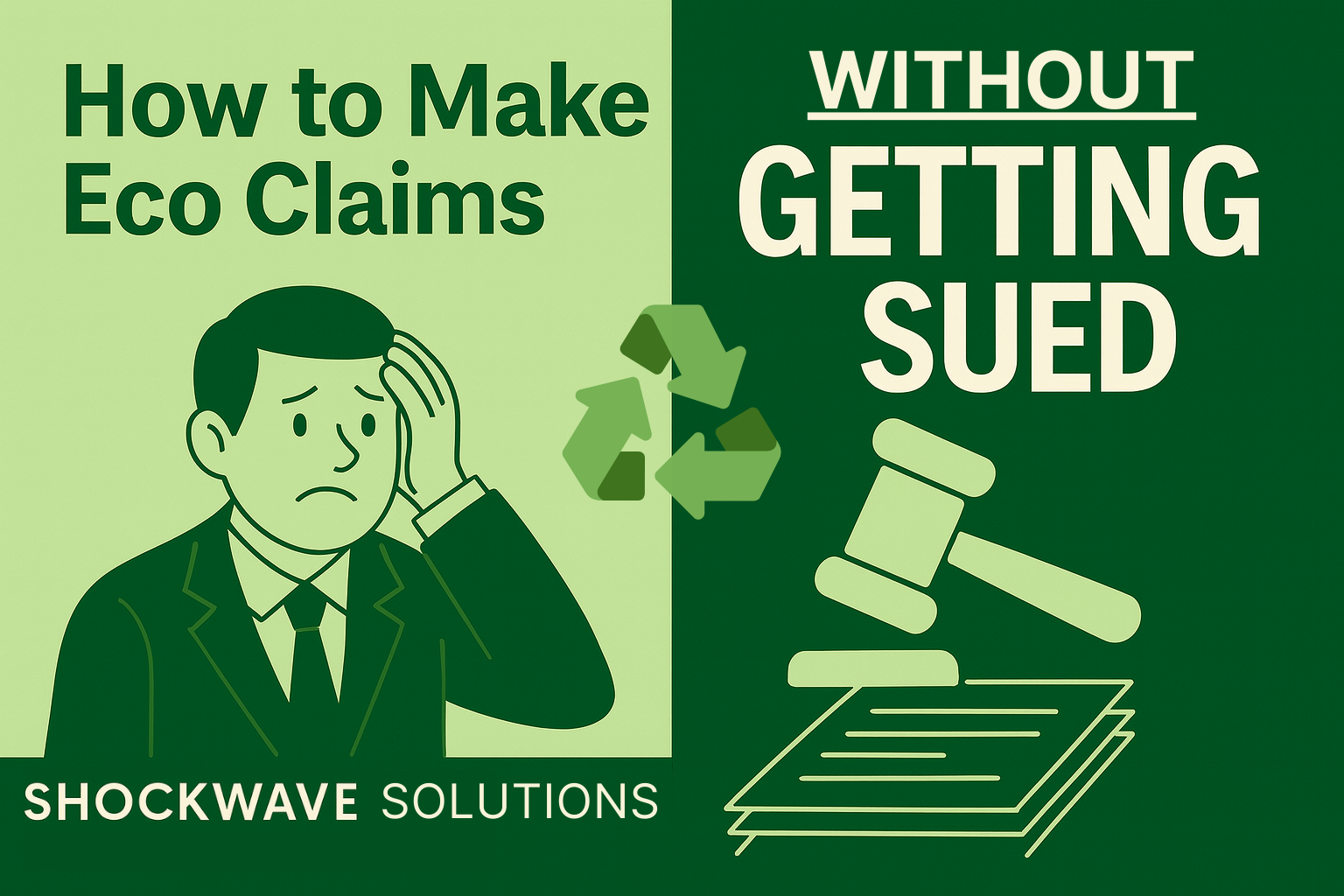Let’s get something straight: slapping “eco-friendly” on your product without hard proof is no longer just a marketing move. It’s a legal liability. The FTC is tightening the screws. California has already dropped the hammer with SB 343. And if you’re still treating “sustainable” as just another buzzword, you’re either about to get sued or go broke fixing the mess you created.
This isn’t theory. It’s happening right now. If you market anything as recyclable, renewable, biodegradable, or environmentally friendly without bulletproof substantiation—you’re in the greenwashing danger zone. And the lawsuits? They’re coming like heat-seeking missiles.
Let’s break down exactly how to make eco claims that hold up in court and convert with confidence.
First, Understand What the Hell Greenwashing Actually Means
Greenwashing = overstating the environmental benefits of your product or packaging. Even if your intentions are pure, if your claims can’t be verified, you’re on thin ice.
Example from the Marketing on Trial Episode: A brand sells bamboo socks. Sounds green, right? Bamboo is renewable. Except… to turn bamboo into rayon, you pump out a toxic soup of chemicals. That “green” claim? Actually a chemical footprint nightmare.
Key takeaway: What sounds good in copy can be catastrophic in court.
The Legal Landscape Has Changed
Here’s what you’re up against:
- FTC’s Updated Green Guides (Coming Soon): These will define what terms like “recyclable”, “biodegradable”, and “compostable” actually mean.
- California SB 343 (In Effect): If 60% of facilities can’t process your product and turn it into new materials, it’s not recyclable. Period.
- Class Action Lawsuits: These are ramping up. Why? Because eco claims are now considered material to the purchasing decision.
Translation: If your green label convinces someone to buy and it turns out to be BS, you’re liable like you lied about a health benefit.
How to Make Eco Claims Without Getting Sued
Here’s the step-by-step framework to keep your marketing aggressive and compliant.
1. Audit Every Claim You’re Making
Do a brutal sweep of your product, packaging, landing pages, and emails. Look for terms like:
- Recyclable
- Biodegradable
- Compostable
- Renewable
- Sustainable
- Made from recycled materials
Ask yourself: Can you back this up with third-party proof?
If not, kill it now or qualify it.
Pro Tip: Saying “recyclable where accepted” is safer than saying “recyclable.”
2. Understand the 60% Threshold Rule
This one trips up almost everyone:
The FTC says: You can’t make an unqualified recycling claim unless at least 60% of consumers have access to a facility that can recycle your product.
California says: Even if 60% have access, the facility must actually sort and recycle the material. It needs to become feedstock for a new product.
So what does this mean for you?
If you’re selling in California (and who isn’t?), your “recyclable” label must pass both access and action thresholds.
- Nail Your Substantiation Binder
If you’re going to make eco claims, build a compliance binder like your business depends on it. Because it does.
Include:
- Maps showing recycling access for your markets
- Waste stream data
- Certifications and test results (ASTM, ISO, etc.)
- Supplier contracts proving material composition
- Statements from recycling facilities
If you can’t hand this binder to a regulator or court tomorrow, your claims aren’t defensible.
- Work With (Not Against) Your Manufacturer
Here’s where a lot of marketers get screwed:
They assume if the manufacturer lets them use a green label, it must be OK.
Wrong.
Most manufacturers are focused on compliance for themselves, not you. If you’re the one putting the label or copy on the packaging, you’re legally liable.
What to do:
- Get documentation directly from your supplier
- Push for up-to-date certifications
- Ask them if they can survive an FTC audit
- Qualify Your Claims
Don’t say: “Our packaging is recyclable.”
Do say: “Our packaging is recyclable where accepted. Check local facilities.”
Don’t say: “Made from recycled materials.”
Do say: “Made with 30% post-consumer recycled content.”
Don’t say: “Biodegradable.”
Do say: “Biodegrades in industrial composting conditions. Not suitable for home composting.”
Clarity protects your ass and builds trust.
- Kill the Eco Claims If They Don’t Move the Needle
Hard truth: Most green claims don’t impact conversion.
If your customer doesn’t care about sustainability (like a 65-year-old buying a joint supplement), your eco claim isn’t helping. It’s just adding risk.
What to do:
- Test with and without the green claim
- Watch for sales lift
- If it doesn’t sell, scrap it before it sinks you
- Know the States That Set the Bar
California: Leads the charge. SB 343 redefines what “recyclable” even means. If you pass there, you’re in good shape.
Oregon, Washington, and New York: All racing to catch up. Their standards may vary.
Stay agile: State-by-state compliance matters. You might be compliant in one and illegal in another.
- Use This Checklist to Stay Legal
- Audit current product claims for FTC and state violations
- Validate recycling access (60% rule)
- Prepare substantiation documentation
- Update language to qualify or clarify claims
- Align with California SB 343 thresholds
- Check manufacturer certs and test results
- Monitor new FTC Green Guide updates
Don’t Just Say You’re Green. Prove It.
Marketing has changed. “Eco-friendly” is no longer a vibe. It’s a compliance commitment. And done right, it’s a conversion asset.
But half-assing it is a one-way ticket to a lawsuit, brand damage, or worse.
So here’s the call to action:
Then go audit your claims, rework your language, and build your substantiation binder like your revenue depends on it.
Because it just might.
Want a done-for-you audit checklist? Grab it free in the Visionary Vault.
Listen to the full podcast episode here, and send it to the marketer on your team who’s still pushing “bamboo is renewable” as a USP.
Frequently Asked Questions Every Marketer Needs to Read Before Making Eco Claims
- Can I say my product is recyclable if most recycling centers don’t accept it?
No. If less than 60% of consumers have access to facilities that accept AND process it, the claim is deceptive. In California, it also needs to become feedstock for a new product. - What if my manufacturer gave me pre-approved green language or labels?
Doesn’t matter. If your brand uses it in marketing or packaging, you are legally liable. Always verify, validate, and demand proof. - Can I say “eco-friendly” without quantifying it?
Nope. Vague language is dangerous. You need to specify: eco-friendly how? Less water? Less energy? Post-consumer content? Be exact—and be ready to back it up. - Is “Made from recycled materials” safe to say?
Only if you disclose the percentage and source. For example: “Made from 30% post-consumer recycled plastic.” Blanket statements are lawsuit bait. - Can I use recycling icons like the chasing arrows?
Not without meeting the 60% access threshold. California bans the use of chasing arrows unless your product qualifies as recyclable under SB 343. - Is biodegradable the same as compostable?
No. And both have strict legal definitions. If it only breaks down in industrial composting, you must say that. Home composting claims are highly regulated. - Do I need third-party certifications to make green claims?
Not required, but strongly recommended. ASTM, ISO, or third-party lab testing adds critical substantiation—and helps you avoid litigation. - If my customers don’t care about sustainability, can I ignore all this?
Yes—and you probably should. Don’t add green claims just for optics. If it doesn’t convert and adds risk, it’s not worth it. - What’s the first step if I already have eco claims on my product?
Audit everything. Packaging, ads, website copy. Flag every green claim. Then verify each one against FTC Green Guides and California SB 343. - What if I don’t meet the 60% rule but still want to keep my claims?
Qualify them. Use statements like: “Recyclable where facilities exist.” Add disclaimers. Clarity protects you from deceptive advertising charges.
This isn’t just about compliance. It’s about credibility.
And if you’re building a premium brand, credibility is everything.
Want to use green claims the right way? Start with this episode. It’s your compliance cheat code.

